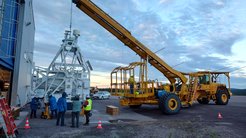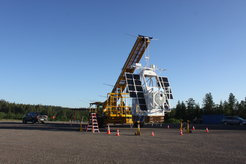Sunrise III is Awaiting Launch
The balloon-borne solar observatory could embark on its stratospheric flight in the next few days.
The adventurous research journey of the balloon-borne solar observatory Sunrise III could begin in the next few days. Early this morning, the so-called compatability test, a kind of final rehearsal, took place at Esrange Space Center in Kiruna, northern Sweden. For this, the solar observatory left the large hangar where the preparations of the last months have taken place, received its final flight configuration and proved on the ground that all systems are working smoothly under flight conditions. Weather permitting, Sunrise III could now take off in the next few days. However, the launch window is rather small. In just a few days, wind conditions in the stratosphere could deteriorate to such an extent that a launch would no longer be possible.

In the past weeks, the mission was initially affected by the difficult global logistics situation; the team had to wait a long time for the balloon and helium to arrive in Kiruna. Recently, weather conditions on site have been unreliable, but as things stand, they allow for individual launch windows in the second half of this week. The next of these opportunities is reserved for XL-Calibur, an American balloon mission. During the past months, both teams have been preparing for their respective flights in the same hangar at Esrange Space Center. The second upcoming launch opportunity is for Sunrise III. However, current forecasts from meteorologists onsite raise concerns. According to these predictions, the stratospheric winds that are supposed to carry Sunrise III safely to Canada could break off in a few days.
If the launch is successful, Sunrise III will have a unique view of the Sun during the subsequent several-day flight at an altitude of 35 kilometers and will, for example, make processes in the chromosphere, the highly dynamic layer between the visible surface and the outer atmosphere of the sun, visible more precisely than ever before.

The balloon-borne solar observatory Sunrise III is a mission of the Max Planck Institute for Solar System Research (MPS, Germany) and the Johns Hopkins Applied Physics Laboratory (APL, USA). Sunrise III looks at the Sun from the stratosphere using a 1-meter telescope, three scientific instruments, and an image stabilization system. Significant contributors to the mission are a Spanish consortium, the National Astronomical Observatory of Japan (NAOJ, Japan), and the Leibniz Institute for Solar Physics (KIS, Germany). The Spanish consortium is led by the Instituto de Astrofísica de Andalucía (IAA, Spain) and includes the Instituto Nacional de Técnica Aeroespacial (INTA), Universitat de València (UV), Universidad Politécnica de Madrid (UPM) and the Instituto de Astrofísica de Canarias (IAC). Other partners include NASA's Wallops Flight Facility Balloon Program Office (WFF-BPO) and the Swedish Space Corporation (SSC). Sunrise III is supported by funding from the Max Planck Foundation, NASA under Grant #80NSSC18K0934, Spanish FEDER/AEI/MCIU (RTI2018-096886-C5) and a “Center of Excellence Severo Ochoa” award to IAA-CSIC (SEV-2017-0709), and the ISAS/JAXA Small Mission-of-Opportunity program and JSPS KAKENHI JP18H05234.

